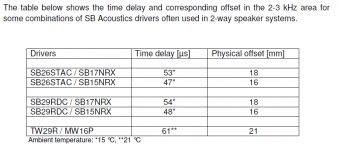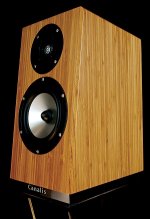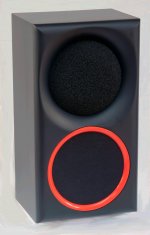hello
i wanna ask you from where we must measure the acoustic center of a driver?
I mean for example from the middle of the coil?
i have two drivers the seas w15ch001 and T29cf002 and i wanna know if they are both mounted on a baffle what would be the offset so i can calculate the delay needed for the tweeter?
i also have the REW and UMIK-1 microphone. i tried to measure using the impulse response the time difference from each driver but without success.
i wanna ask you from where we must measure the acoustic center of a driver?
I mean for example from the middle of the coil?
i have two drivers the seas w15ch001 and T29cf002 and i wanna know if they are both mounted on a baffle what would be the offset so i can calculate the delay needed for the tweeter?
i also have the REW and UMIK-1 microphone. i tried to measure using the impulse response the time difference from each driver but without success.
I would guess the time alignment correction for a 5.5" bass and a regular sort of tweeter is likely to be about 2cm. You could probably place the acoustic centre at the centre of the voicecoil. So the woofer is set back about 3-4 cm, and the tweeter about 1-2 cm.
SB Acoustics :: Technical Notes
At 3kHz, a half wavelength of sound is about 5cm, or 180 degrees phase. At lower crossover frequencies it matters less. Maybe you can judge it from Joachim Gerhard's lovely Canalis Anima which is a bass like yours, but time aligned.
TBH, I can never hear exact phase matching all that much, and I certainly wonder why people seek that deep null in antiphase. It's always debateable whether a speaker sound better above, below or exactly on-axis.
SB Acoustics :: Technical Notes
At 3kHz, a half wavelength of sound is about 5cm, or 180 degrees phase. At lower crossover frequencies it matters less. Maybe you can judge it from Joachim Gerhard's lovely Canalis Anima which is a bass like yours, but time aligned.
TBH, I can never hear exact phase matching all that much, and I certainly wonder why people seek that deep null in antiphase. It's always debateable whether a speaker sound better above, below or exactly on-axis.
Attachments
Some say where the coil former meets the cone. I use HolmImpulse to measure, relative distance can be established because it can be counted on to start from the same time at each measurement.
I don't think it does matter at all whether the reverse null is on axis or less so.
All I suspect that matters is the axial response, the response elsewhere, where that energy goes (to what wall), and the group delay.
At 3k5Hz, 2.5cm on its own will not be critical. Also at the crossover frequency it will introduce that much discrepancy per order of roll-off.
If the drivers are not time aligned, a crossover might need to be a little assymetrical. As to whether this matters?.... Still, you want to know the distance.
Completely agree.TBH, I can never hear exact phase matching all that much, and I certainly wonder why people seek that deep null in antiphase. It's always debateable whether a speaker sound better above, below or exactly on-axis.
I don't think it does matter at all whether the reverse null is on axis or less so.
All I suspect that matters is the axial response, the response elsewhere, where that energy goes (to what wall), and the group delay.
At 3k5Hz, 2.5cm on its own will not be critical. Also at the crossover frequency it will introduce that much discrepancy per order of roll-off.
If the drivers are not time aligned, a crossover might need to be a little assymetrical. As to whether this matters?.... Still, you want to know the distance.
I know this is an old thread but I wanted to resurrect it because that article is excellent! Mystery is solved for me in a very easy-to-understand way. A big thanks, to Jeff Bagby.
It is more complicated than the coil location. Sound travels from the coil through the former to the cone at a speed faster than sound through air. The cone radiates into the air at different points depending on frequency. So the acoustic center is frequency dependent but usually somewhere forward of the coil and probably closer to the dust cap.
SWAG
To a first approximation for a cone driver:
at the centroid of the diaphragm section bounded by a straight line extending across the surround extents.
The issue of time differences between drivers should be addressed by digital signal processing means and/or use of a HF horn. Far more important is matching the radiation patterns emanating from a common baffle. See the designs of Earl Geddes for this [1]. Here the radiating areas (and radiation patterns as well, particularly in the c/o region) of the horn mouth and that of L.F. driver are approximately equal.
Regards,
WHG
hello
i wanna ask you from where we must measure the acoustic center of a driver?
I mean for example from the middle of the coil?
i have two drivers the seas w15ch001 and T29cf002 and i wanna know if they are both mounted on a baffle what woulde the offset so i can calculate the delay needed for the tweeter?
i also have the REW and UMIK-1 microphone. i tried to measure using the impulse response the time difference from each driver but without success.
To a first approximation for a cone driver:
at the centroid of the diaphragm section bounded by a straight line extending across the surround extents.
The issue of time differences between drivers should be addressed by digital signal processing means and/or use of a HF horn. Far more important is matching the radiation patterns emanating from a common baffle. See the designs of Earl Geddes for this [1]. Here the radiating areas (and radiation patterns as well, particularly in the c/o region) of the horn mouth and that of L.F. driver are approximately equal.
Regards,
WHG
Attachments
The three milli-sec difference between the arrival of sound between the tweeter, midrange, and woofer, is in the large box of critical engineering measurements that cannot be heard while listening to music.
No measurements are done with music; all are done with test tones or pink noise or other stuff like that.
The bottom line that should always be asked but almost always is ignored, is : "What will be the environmental impact?"
In this case the environmental impact is your ear/auditory cortex system.
No measurements are done with music; all are done with test tones or pink noise or other stuff like that.
The bottom line that should always be asked but almost always is ignored, is : "What will be the environmental impact?"
In this case the environmental impact is your ear/auditory cortex system.
You can't hear 3 milliseconds, but you sure can hear 3mSeconds of misalignment.
A Speaker Maker's Journey: LM-1 Testing Driver Distances
A Speaker Maker's Journey: LM-1 Testing Driver Distances
You can't hear 3 milliseconds, but you sure can hear 3mSeconds of misalignment.
A Speaker Maker's Journey: LM-1 Testing Driver Distances
Your post is about the measuring not the hearing. Read up on the Haas Effect. You cannot hear anything within 30-100 milliseconds of the first sound that comes to your ears---when listening to music. Yes, if you listen to a test tone, you may be able to do so---if you train yourself.
Put on Bela Fleck and the Flecktones and tell me that you can hear a 2 inch misalignment of the centers of the speakers. Music is what we have speakers for.
In real life the trombones are much further back in the symphony from the violins, but you don't hear the "misalignment" of that sound either.
This is an engineering discussion about splitting hairs of measurements. Next thing you'll be telling me that you can hear the difference between amplifiers, and have taken the $10K from Richard Clarke.
At 343 meters/second, a 32 mm offset is only about 0.093 ms. That is enough to represents a 108 degree offset at a 3200Hz crossover frequency. The summation error at that point would be almost -5dB.
That is lost music Zarathu.
That is lost music Zarathu.
Your post is about the measuring not the hearing. Read up on the Haas Effect. You cannot hear anything within 30-100 milliseconds of the first sound that comes to your ears---when listening to music. Yes, if you listen to a test tone, you may be able to do so---if you train yourself.
Put on Bela Fleck and the Flecktones and tell me that you can hear a 2 inch misalignment of the centers of the speakers. Music is what we have speakers for.
In real life the trombones are much further back in the symphony from the violins, but you don't hear the "misalignment" of that sound either.
This is an engineering discussion about splitting hairs of measurements. Next thing you'll be telling me that you can hear the difference between amplifiers, and have taken the $10K from Richard Clarke.
You are missing the point. In a orchestra you hear the entire trombone arrive later. The microphone already picked that up. What you don't hear is the lower and upper frequencies arriving at different times and adding incorrectly at the overlap point. You are confusing your concepts.
You are missing the point. In a orchestra you hear the entire trombone arrive later. The microphone already picked that up. What you don't hear is the lower and upper frequencies arriving at different times and adding incorrectly at the overlap point. You are confusing your concepts.
OK... I can be more practical. I have a line array system which uses a Rane electronic crossover. This crossover has a dial knob that allows me to modify the sound delay between the three speakers. While listening to music(not test tones), I have had my wife slowly move the knob from 7:00 to 5:00 in all of the ranges, effectively modifying the delay caused by the mis alignment of the speakers.
To the life of me, while listening to music, I could not hear a difference.
While listening to a test tone sweep or to a constant pink noise, I think I might have heard a difference, but I cannot be positive. I doubt whether I could have consistently picked it out.
Last edited:
And remember the issue is going to take place most in the ranges at or near the crossover (Phase, Time and Distortion in Loudspeakers).
If you are using a steep 24 db L-R electronic cross(with phase adjustments), then both the characteristics of of the deep cross and the actual Linkwitz-Riley parameters are going to come into play. This may have something to do with my not hearing it.
If you are using a steep 24 db L-R electronic cross(with phase adjustments), then both the characteristics of of the deep cross and the actual Linkwitz-Riley parameters are going to come into play. This may have something to do with my not hearing it.
Again different concepts. In a line array (if that is what you have) you are reproducing the entire range in one driver. In a multi-way system, your frequencies are split relatively sharply between two or more drivers. If they do not sum up properly at the crossover you will get significant dips in the response. The worst case is if the offset coincides with 180 degrees. Then you will get a full null. It is a matter of summing up the outputs of the drivers at the overlap. I can definitely hear the difference if I physically slide the tweeter back to even with the mid. Is sounds like a rough discontinuity.
(if that is what you have)
I think we are going no where with this, aren't we, when you start reverting to accusing me of lying because my experience fails to match yours. And when you apparently don't read my posts.
Moving on.....
Last edited:
I am not accusing you of anything. I am simply trying to understand from your description if my interpretation is correct. When you say line source I assume full range drivers. All I wanted was confirmation that it was so.
Wrong!
These observations have noting to do with how the acoustical signals from two drivers covering different frequency domains interact, particularly in the c/o overlap region. The anomalies that arise from ignoring these issues may be audible when the timing issues are significant. What is being split here are the signals of each instrument no matter where they located with respect to microphone(s) used to record them.
Regards,
WHG
Your post is about the measuring not the hearing. Read up on the Haas Effect. You cannot hear anything within 30-100 milliseconds of the first sound that comes to your ears---when listening to music. Yes, if you listen to a test tone, you may be able to do so---if you train yourself.
Put on Bela Fleck and the Flecktones and tell me that you can hear a 2 inch misalignment of the centers of the speakers. Music is what we have speakers for.
In real life the trombones are much further back in the symphony from the violins, but you don't hear the "misalignment" of that sound either.
This is an engineering discussion about splitting hairs of measurements. Next thing you'll be telling me that you can hear the difference between amplifiers, and have taken the $10K from Richard Clarke.
These observations have noting to do with how the acoustical signals from two drivers covering different frequency domains interact, particularly in the c/o overlap region. The anomalies that arise from ignoring these issues may be audible when the timing issues are significant. What is being split here are the signals of each instrument no matter where they located with respect to microphone(s) used to record them.
Regards,
WHG
I tried, I really did, but an expert is in our midst, and there is nothing I could possibly add to his understanding.
Erik
Erik
I think we are going no where with this, aren't we, when you start reverting to accusing me of lying because my experience fails to match yours. And when you apparently don't read my posts.
Moving on.....
I can double blind identify when I have -1.5cm worth of time alignment enabled for the woofers on my main speakers, and this is just using music, no test tones.
When phase is as good as it can be, the soundstage, pace, rhythm and timing just all get cranked up to 11.
- Home
- Loudspeakers
- Multi-Way
- driver acoustic center


